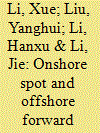|
|
|
Sort Order |
|
|
|
Items / Page
|
|
|
|
|
|
|
| Srl | Item |
| 1 |
ID:
178314


|
|
|
|
|
| Summary/Abstract |
Why do Chinese governments at various levels set up public complaint websites where citizen petitions and government responses can be reviewed by the general public? We argue that it is the result of two factors: strong signals sent by the central government to improve governance, and the availability of new technologies to promote policy innovation. To impress their superiors, local officials adopted newly available commercial technology to innovate existing citizen feedback systems, which presented a developmental trajectory from “openness,” “integration,” to “big data-driven prediction.” Drawing on policy documents and interviews with local politicians and administrators, we provide a chronological perspective of how technical development, central government’s signals and local decision-making have interacted in the past two decades to bring forth today’s public complaint websites. The contingent and non-teleological nature of this development can also be applied to other policies such as the social credit system.
|
|
|
|
|
|
|
|
|
|
|
|
|
|
|
|
| 2 |
ID:
192331


|
|
|
|
|
| Summary/Abstract |
This paper examines the impact of capital goods imports on firms' export quality upgrading with a subsidy policy for advanced capital imports implemented in China since 2008. Using a matched dataset of firms' production and custom data, we employ a difference-in-differences strategy that exploits firms' differential pre-event exposures to the policy. We find that the subsidy policy increases firms' imports of subsidized products, and improves their export quality. Furthermore, export quality improvements due to capital goods imports are larger if (1) firms are more productive; (2) the exporting product is the firm's core product; (3) the product is a differentiated good; and (4) the destination market is larger and richer. Further analysis suggests that capital goods imports can also boost firms' total exports and the number of exporting destinations and products. The mechanism tests reveal that capital-skill complementarity can explain improved export product quality through capital goods imports. Capital goods imports also lead to increased skill management that can improve export quality as well.
|
|
|
|
|
|
|
|
|
|
|
|
|
|
|
|
| 3 |
ID:
182746


|
|
|
|
|
| Summary/Abstract |
This paper investigates the dynamic relationship between the onshore spot market and offshore forward market for Chinese currency around the period of China's “8.11” exchange rate regime reform, one of the most important market-oriented reforms implemented on August 11, 2015. We compare return and volatility spillover effects between the two markets before and after the “8.11” reform. The empirical evidence shows that a remarkable change has occurred in both the return and volatility spillovers. Before the reform, return and volatility spillovers exist from the offshore forward market to the onshore spot market. After the reform, however, we observe an obvious reverse in the direction and an increase in the strength of the return and volatility spillover effects. These findings suggest the existence of cross-market information flows, a change in the direction and a strengthening of the dynamic relationship after the reform. We argue that the “8.11” reform serves as a milestone reflecting long-term underlying forces that increase the relative importance of the onshore market.
|
|
|
|
|
|
|
|
|
|
|
|
|
|
|
|
| 4 |
ID:
148693


|
|
|
|
|
| Summary/Abstract |
Using data for the period 2000–2011, we construct province-level real effective exchange rate (REER) indices for China and test the effect of REER depreciation on regional economic growth in a generalized method of moments regression framework. Our results show that REER depreciation, in general, promotes regional economic growth, through increasing net exports and lowering FDI costs. After dividing the full sample into coastal and inland subsamples, we find that REER depreciation influences economic growth in inland areas but not in coastal areas. This is due to the fact that the inland areas have more surplus labor or other resources to expand their production capacity when REER depreciation leads to increased world demand. Furthermore, compared to inland areas, processing-and-assembly trade comprises a larger share of trade in the coastal areas, where traders import more raw materials and intermediate goods to process and assemble goods. When the exchange rate depreciates, the costs of imported materials and immediate goods increase. In this case, the benefits from REER depreciation in coastal areas are offset to some extent and are thus lower than in inland areas.
|
|
|
|
|
|
|
|
|
|
|
|
|
|
|
|
|
|
|
|
|